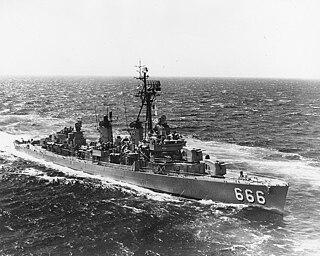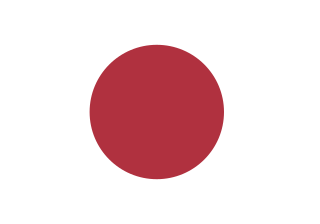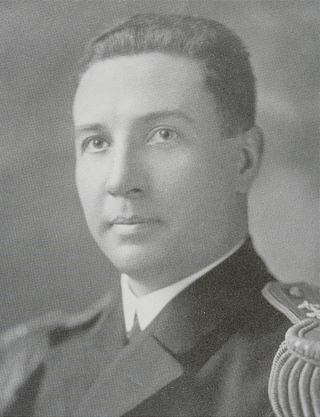Related Research Articles

USS Wake (PR-3) was a United States Navy river gunboat operating on the Yangtze River. Originally commissioned as the gunboat Guam (PG-43),she was redesignated river patrol vessel PR-3 in 1928,and renamed Wake 23 January 1941. She was captured by Japan on 8 December 1941 and renamed Tatara. After her recapture in 1945,she was transferred to Chinese nationalists,who renamed her Tai Yuan. Communist forces captured her in 1949. On 1 May 1949 Tai Yuan was sunk by Nationalist aircraft in the Caishiji River.

USS Gillis (DD-260/AVD-12) was a Clemson-class destroyer in the United States Navy. She was named for Commodore John P. Gillis and Rear Admiral James Henry Gillis.

USS Black (DD-666) was a Fletcher-class destroyer of the United States Navy.

USS Luzon (ARG-2) was an internal combustion engine repair ship in service with the United States Navy from 1943 to 1947 and from 1950 to 1960. She was the lead ship in a class of twelve ships and was scrapped in 1974.

USS Catskill (LSV-1) was a vehicle landing ship built for the United States Navy during World War II. The lead ship of her class,she was named for the Catskill Mountains in southeastern New York State.

The Battle of Guam was an engagement during the Pacific War in World War II,and took place from 8 December to 10 December 1941 on Guam in the Mariana Islands between Japan and the United States. The American garrison was defeated by Japanese forces on 10 December,which resulted in an occupation until the Second Battle of Guam in 1944.

USS Baron (DE-166) was a Cannon-class destroyer escort in service with the United States Navy from 1943 to 1946. In 1952,she was transferred to Uruguay where she served as ROU Uruguay (DE-1) until 1990.

USS Sterope (AK-96) was a Crater-class cargo ship commissioned by the U.S. Navy for service in World War II. She was responsible for delivering troops,goods and equipment to locations in the war zone.
USS Alkaid (AK-114) was a Crater-class cargo ship,converted from a Liberty Ship,commissioned by the US Navy for service in World War II. She was first named after William G. Sumner,a classical liberal American social scientist. She was renamed and commissioned after Alkaid,a star in the Big Dipper asterism or constellation Ursa Major. She was responsible for delivering troops,goods and equipment to locations in the war zone.

The Japanese occupation of Guam was the period in the history of Guam between 1941 and 1944 when Imperial Japanese forces occupied Guam during World War II. The island was renamed Ōmiya-Jima.

USS Oneida (APA-221) was a Haskell-class attack transport in service with the United States Navy from 1944 to 1946. She was scrapped in 1975.

USS Hollis (DE-794/APD-86) was a Buckley-class destroyer escort in service with the United States Navy from 1944 to 1947 and from 1951 to 1956. She was scrapped in 1975.

USS Knudson (APD-101),ex-DE-591,later LPR-101,was a United States Navy high-speed transport in commission from 1944 to 1946 and from 1953 to 1958.

USS Odum (APD-71),ex-DE-670,was a United States Navy high-speed transport in commission from 1945 to 1946.

Roy Campbell Smith was an American naval officer and the Governor of Guam from 1916 to 1918.

George Andrew Alexander was a United States Navy Captain who served as the 35th Naval Governor of Guam. Prior to serving as governor,he commanded USS Medusa. As Governor of Guam,he greatly changed the judicial system by purging the island of leftover Spanish laws and replacing them with the Code of Guam. He also led an unsuccessful campaign to obtain United States citizenship for all residents of Guam. After his term as governor,he commanded USS Arizona before retiring.
Benjamin Vaughan McCandlish was a United States Navy flag officer who served as the 36th Naval Governor of Guam and was a recipient of the Navy Cross.

George Johnson McMillin was a United States Navy rear admiral who served as the 38th and final naval governor of Guam. He served as an officer during four separate conflicts:World War I,the occupation of the Dominican Republic,the United States occupation of Veracruz,and World War II. He served on the staff of both the Naval Academy and the Naval War College as well. He is most remembered as the commander who surrendered Guamanian forces to a much larger Japanese force during the First Battle of Guam,only the second battle of World War II involving the United States. He had previously evacuated all but one civilian American citizen from the island and attempted to rebuild defenses after a strong typhoon devastated the island the year before. On December 8,1941,Japanese forces invaded Guam and McMillin surrendered two days later. He spent the rest of the war at various Japanese prisoner of war camps.

USS Guam was an Alaska-class large cruiser which served with the United States Navy during the last year of World War II. She was the second and last ship of her class to be completed. The ship was the second vessel of the US Navy to be named after the island of Guam,an American territory in the Pacific,and she was assigned the hull number CB-2. Due to her commissioning late in the war,Guam saw relatively limited service during the war. She participated in operations off Okinawa in March–July 1945,including providing anti-aircraft defense for the carrier task force and conducting limited shore bombardment operations. She participated in sweeps for Japanese shipping in the East China and Yellow Seas in July–August 1945. After the end of the war,she assisted in the occupation of Korea and transported a contingent of US Army troops back to the United States. She was decommissioned in February 1947 and placed in reserve,where she remained until she was stricken in 1960 and sold for scrapping the following year.

Sumay,also Sumai,was a village on the United States territory of Guam. It was located on the north coast of the Orote Peninsula along Apra Harbor. It was inhabited by Chamorro people before contact with Europeans. Sumay became a prosperous port town serving whalers and other sailors in the 1800s and the second most populous settlement on Guam after Hagåtña,the capital of the Spanish Mariana Islands. Following the Capture of Guam by the United States in 1898,the village was the site of Marine Barracks Guam. In the early 1900s,it was a link for two firsts connecting the United States and Asia:the first submarine communications cable for telegraph and the China Clipper,the first air service. After the Japanese invasion of Guam in 1941,the residents were evicted and the village turned into a Japanese military garrison. Sumay was leveled during the U.S. liberation of the island in 1944. The U.S. military prohibited the residents from returning,relocating them to the hills of nearby Sånta Rita-Sumai. In 1948,the U.S. military exercised eminent domain and took all private and commercial property at Sumay. Its former location is now on Naval Base Guam.
References
- ↑ "Guam Naval Governors 30 August 1899 – 10 December 1941". guampedia.com. 12 January 2010. Retrieved November 8, 2021.
- ↑ "SURRENDER OF GUAM TO THE JAPANESE - The Report of George J. McMillin, Captain, USN". nps.gov. 1972. Retrieved November 8, 2021.
- ↑ "Naval History and Heritage Command - USS Guam (CB-2)". navy.mil. Retrieved November 9, 2021.
- ↑ "Maritime Notes". San Pedro News Pilot. November 23, 1943. p. 5. Retrieved November 15, 2021.
- ↑ "AU History Photograph and Print Collection". wrlc.org. June 1945. Retrieved November 9, 2021.
- ↑ "War prisoner's wife christens big ship". ucr.edu. Daily News (Los Angeles). May 25, 1945. Retrieved November 9, 2021.
- ↑ "McMillin, Annabel Parlett". pastperfectonline.com. Retrieved November 9, 2021.
- ↑ "Capt. McMillin Writes His Health is 'Splendid'". The Vindicator . Youngstown, Ohio. The Vindicator Printing Co. August 12, 1944. p. 1. Retrieved November 8, 2021.
- ↑ BUREAU OF NAVAL PERSONNEL INFORMATION BULLETIN - THREE NAVY DAUGHTERS WIN SCHOLARSHIPS (PDF). August 1942. p. 60. Retrieved November 8, 2021.
{{cite book}}:|website=ignored (help)